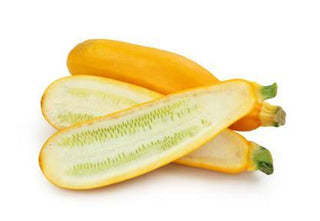(Cucurbita pepo)
Once you see summer squash in the vegetable aisle of the grocery store you know that it’s summer. A relative of the melon and cucumber, summer squash is a member of the Cucurbitaceae family. This plant family consists of other familiar members such as pumpkins and watermelons.
Summer squash refers to a number of squashes that are picked while immature. Unlike winter squash, summer squash are characterized by having tender, edible rinds, resulting in a relatively short-shelf life. Summer squashes include cousa squash, pattypan squash (resembles a flying saucer), yellow crookneck squash, yellow summer squash and zucchini. Although they vary in color from white, green, light green and yellow, summer squash can be used interchangeably in most recipes because most are similar in texture and flavor.
History
Developed from wild squash, squash originated in Mexico and Guatemala. Originally, squash was cultivated only for its seeds because the flesh was bitter and the taste was unpalatable. Squash, along with corn and beans, was one of the “Three Sisters” planted by Native Americans. The flavor became sweeter as the cultivation progressed throughout North and South America. Today, the major cultivators of summer squash include China, Japan, Italy, Egypt and Argentina.
Nutrition Facts
While summer squash is not packed with nutrients like broccoli and some other vegetables, at just 18 calories per one cup serving, it works well for dieters and health conscious eaters. A cup of summer squash contains just 4 grams of carbohydrates, of which half is from dietary fiber. Surprisingly, summer squash is also a good source of protein.
Summer squash is a very good source of vitamin C (19 mg or 32%). A one cup serving also supplies about 10 percent of the Daily Values for riboflavin, vitamin B6, folate, magnesium, potassium and manganese.
The dark green and yellow skin of summer squash comes from two carotenoids, lutein and zeaxanthin, both which are potent antioxidants.
Selection & Storage
The colorful exterior of summer squash can be seen all-year around; however, this vegetable is best between May and July.
While selecting, search for squash that has a shiny exterior. Pick squash that is small to medium in size, firm and with skin that is free of marks. Avoid large sized squash that contains hard, over mature rinds as the flesh will be too chewy. If squash is too small, the flesh will not be rich in flavor.
Unlike winter squash, summer squash is very delicate. Any damage to the exterior will cause decomposition. When storing, place the squash into a bag and store it in the refrigerator for up to seven days. Do not wash the squash until you are preparing it for consumption.
Recipes
This versatile squash can be incorporated into a wide variety of culinary dishes. It can be stir fried, steamed, grilled, stuffed and baked. Summer squash also makes an excellent sautéed side dish. This versatile squash can be prepared with other vegetables such as eggplant and carrots. Summer squash is a great addition to a tray of crudités along with other traditional vegetables. Or, try shredding and adding to a salad.
To perfect your grilling technique, checkout Epicurious Grilled Summer Squash and Zucchini recipe.
Looking for a new way to prepare squash? This Zucchini Pasta recipe is a novel way to prepare a healthy “pasta” dish.
Fun Facts
Christopher Columbus brought squash to Europe from the New World in the late 1400s.
For culinary purposes summer squash is considered a vegetable but technically it is a fruit. Botanists have classified this fruit as a pepo, or fleshy, seeded berry.

